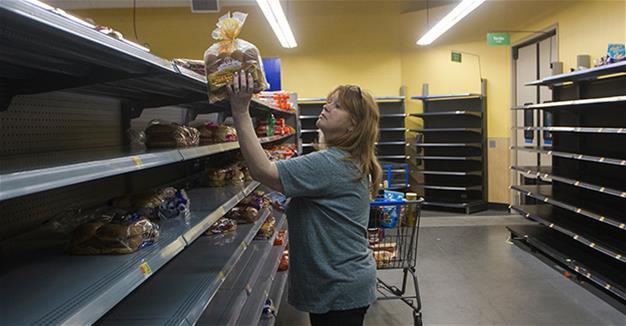Millions brace as Hurricane Harvey menaces Texas

Hurricane Harvey intensified early on Aug. 25, spinning into potentially the biggest hurricane to hit the U.S. mainland in more than a decade, with life-threatening floods expected along the Gulf Coast.
Hurricane Harvey grew into a category 2 storm with winds of 105 mph (169 kph) as it moved northwest about 355 km off Corpus Christi, Texas, the National Hurricane Center said in an advisory. It's forecast to make landfall late Aug. 25 or early Aug. 26.
Up to 35 inches (97 cm) of rain are expected over parts of Texas, with winds up to 125 mph, and sea levels may surge as high as 12 feet (3.7 meters). Louisiana could get 10 to 15 inches of rain. Flood warnings are in effect for Louisiana and northern Mexico.
"Life-threatening and devastating flooding expected near the coast due to heavy rainfall and storm surge," the hurricane center said.
The storm's approach has triggered evacuations and canceled the first day of school in communities along the south Texas coast, which is home to 5.8 million people from Corpus Christi to Galveston.
Energy companies shut coastal refineries, pulled workers from offshore oil platforms in the Gulf of Mexico and halted onshore drilling in south Texas on Aug. 24. By midday, just under 10 percent of offshore U.S.
Gulf of Mexico crude output capacity and nearly 15 percent of natural gas production had been halted, government data showed.
Louisiana and Texas declared states of disaster, authorizing the use of state resources to prepare for the storm. President Donald Trump has been briefed and stands ready to provide resources if needed, the White House said on Aug. 24.
Harvey is forecast to come ashore as a Category 3 hurricane, the U.S. National Hurricane Center said, the third most powerful on the Saffir-Simpson scale. That would make it the first major hurricane to hit the mainland United States since Hurricane Wilma struck Florida in 2005.
The NHC expects Harvey to move slowly over Texas and linger over the state for days. Houston, the nation's fourth most populous city, warned residents of flooding from close to 20 inches of rain over several days.
The NHC expects the storm to come ashore along the central Texas coast, an area that includes Corpus Christi and Houston, home to some of the biggest refineries in the country.
More than 45 percent of the country's refining capacity is along the U.S. Gulf Coast, and nearly a fifth of the nation's crude oil is produced offshore in the region. Ports from Corpus Christi to Texas City, Texas, were closed to incoming vessels.
Harvey has already disrupted U.S. oil supplies in the region.
Three refineries in Corpus Christi and one farther inland at Three Rivers were shutting down ahead of the storm. Concern that Harvey could cause shortages in fuel supply drove benchmark gasoline prices to a three-week high.
One other refinery reduced output and others were considering shutting.
Prices for gasoline in spot physical markets on the Gulf Coast rose even more, hitting a one-year high.
Profit margins for refineries producing gasoline rose by more than 12 percent on Aug. 24, on course for their biggest daily percentage gain in six months, according to Reuters data.
Royal Dutch Shell Plc, Anadarko Petroleum Corp and Exxon Mobil Corp have evacuated staff from offshore oil and gas platforms in the storm's path.
The U.S. government said 9.6 percent of crude output capacity was shut and 14.6 percent of natural gas production was halted.
The storm could also bring flooding to shale oil fields in southern Texas that produce more than one million barrels of oil a day.
EOG Resources Inc said it has curtailed drilling and shut in some production in the Eagle Ford shale region. Noble Energy Inc and Statoil ASA also said it was evacuating some staff from production facilities.
 Hurricane Harvey intensified early on Aug. 25, spinning into potentially the biggest hurricane to hit the U.S. mainland in more than a decade, with life-threatening floods expected along the Gulf Coast.
Hurricane Harvey intensified early on Aug. 25, spinning into potentially the biggest hurricane to hit the U.S. mainland in more than a decade, with life-threatening floods expected along the Gulf Coast.